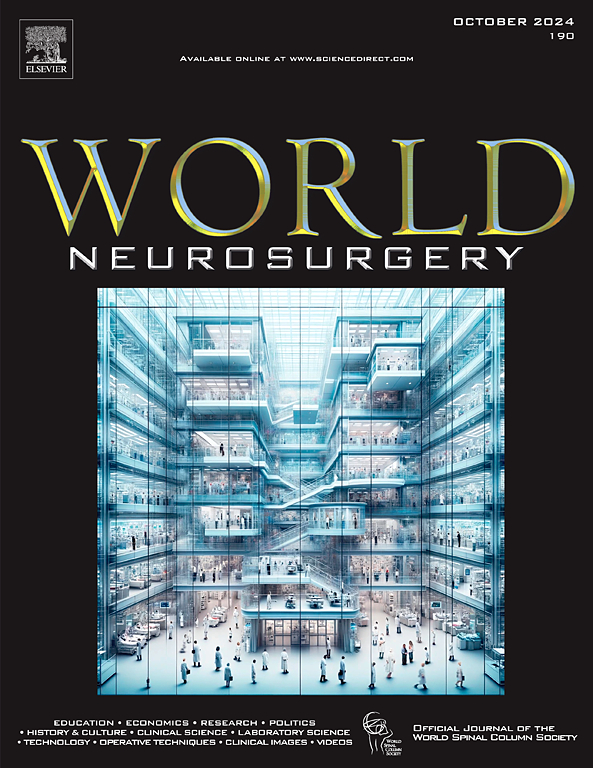The Importance of Alignment in the Management of Thoracolumbar Trauma
IF 2.1
4区 医学
Q3 CLINICAL NEUROLOGY
引用次数: 0
Abstract
Spinal injuries occur in 3% of all patients with trauma, most commonly in males, and often as a result of high-velocity impact followed by abrupt deceleration. The most affected region after spinal trauma is the thoracolumbar junction because of the anterior center of gravity at the T12-L1 vertebral level and the relatively stiff thoracic spine uniting with the mobile lumbar spine. Many classifications exist to guide the choice of operative versus nonoperative management of traumatic injuries at this site. However, the classifications do not consider the segmental alignment of the spine, an aspect that has been shown to improve quality of life in nontraumatic postoperative spinal patients. Ignoring this aspect of thoracolumbar management often contributes to the development of posttraumatic malalignment and other complications. This review recommends that a new or modified classification system accounts for sagittal segmental alignment factors, including the level of the injured vertebra, the number of affected adjacent levels, imaging techniques with better specificity and sensitivity, and assessment for osteoporosis. Case studies are included to show the importance of segmental sagittal alignment and the vertebral level on patient outcomes.
对齐在治疗胸腰椎创伤中的重要性。
脊柱损伤发生率占所有创伤患者的 3%,最常见于男性,通常是由于高速撞击后突然减速所致。脊柱创伤后受影响最大的区域是胸腰椎交界处,这是因为重心位于 T12-L1 椎体水平的前方,以及相对僵硬的胸椎与活动的腰椎相连。目前有许多分类方法可用于指导对该部位的外伤进行手术或非手术治疗。然而,目前的分类方法并没有考虑脊柱的节段对齐情况--这一点已被证明可以提高非创伤性脊柱术后患者的生活质量。忽视这方面的胸腰椎管理往往会导致创伤后错位和其他并发症的发生。本综述建议,新的或修改后的分类系统应考虑矢状节段对位因素,包括受伤椎体的水平、受影响的相邻水平的数量、特异性和灵敏度更高的成像技术以及骨质疏松症评估。该系统还包括病例研究,以证明节段矢状排列和椎体水平对患者预后的重要性。
本文章由计算机程序翻译,如有差异,请以英文原文为准。
求助全文
约1分钟内获得全文
求助全文
来源期刊

World neurosurgery
CLINICAL NEUROLOGY-SURGERY
CiteScore
3.90
自引率
15.00%
发文量
1765
审稿时长
47 days
期刊介绍:
World Neurosurgery has an open access mirror journal World Neurosurgery: X, sharing the same aims and scope, editorial team, submission system and rigorous peer review.
The journal''s mission is to:
-To provide a first-class international forum and a 2-way conduit for dialogue that is relevant to neurosurgeons and providers who care for neurosurgery patients. The categories of the exchanged information include clinical and basic science, as well as global information that provide social, political, educational, economic, cultural or societal insights and knowledge that are of significance and relevance to worldwide neurosurgery patient care.
-To act as a primary intellectual catalyst for the stimulation of creativity, the creation of new knowledge, and the enhancement of quality neurosurgical care worldwide.
-To provide a forum for communication that enriches the lives of all neurosurgeons and their colleagues; and, in so doing, enriches the lives of their patients.
Topics to be addressed in World Neurosurgery include: EDUCATION, ECONOMICS, RESEARCH, POLITICS, HISTORY, CULTURE, CLINICAL SCIENCE, LABORATORY SCIENCE, TECHNOLOGY, OPERATIVE TECHNIQUES, CLINICAL IMAGES, VIDEOS
 求助内容:
求助内容: 应助结果提醒方式:
应助结果提醒方式:


